“Say ‘Guìlín’ and watch the looks of rapture (and pride) on the faces of Chinese people. Dotted with supernaturally lovely karst topography gracing the Li River (Li Jiāng) – these bizarre limestone upthursts shape-shifting in dancing mists and haze – the city’s beauty has been celebrated for generations by painters and poets.” This is how the Lonely Planet guide book on China starts describing Guilin. Thereafter also come some warnings about dminished charme due to modern development and cashing-in on the tourist attractions. But prepared with such statements you nonetheless start your journey with highest expectations.
Guilin was not our first choice for a destination over Chinese Spring Break. I had dreamed of going to Vietnam. Hotel in Hanoi and trip to Halong Bay was already reserved before I figured out that there are no direct flights from Shanghai to Hanoi (actually: to nowhere in Vietnam). And with a stopover in or near Hongkong the travel time would be a full day and would also be quite expensive. With only 5 days of available time we dropped the plan and looked for a domestic destination; not a thing you long for when half China is travelling. But Guiling / Li River / Yangshuo sounded so fantastic that I even considered it a full replacement for Vietnam. And to summarize: I haven’t been the last time in Yangshuo! [And I indeed made it a second time some months later.]
Monday, 19-FEB-2007: Arrival
But probably in Guilin. [Couldn’t avoid getting there again, too, but it’s a good basis to get to the LongJi Rice Terraces.]
With our high expectations, and despite knowing about comparably high entry fees for the attractions, we got a bit disappointed. We arrived in the evening at Guilin Liang Jiang International Airport (no, no typo, “Liang Jiang” means “2 rivers”, while “Li Jiang” is the name of one individual river). That airport is brand-new, quick, comparibly small, so ways are short. Except for the way into Guilin city. I don’t know who had the crazy idea to build this airport in the middle of nowhere, nearly 30km south-west of Guilin. The cheapest way of transportation is by Minibus, which still is 20RMB per person. And you get dropped of somewhere… But somehow we are always a bit on the cost-cutting trip.
Luckily, with Carol’s native Chinese, we were able to find our way, avoiding cheating taxi drivers, who offer 40RMB for a trip around the corner. They probably underestimated my sense of orientation, despite poor-quality maps, which only I could get from the internet. Carol’s chat with some locals at a bus stop told us two things: 1. there is a bus going close to our hotel for just 1.20RMB, 2. there is a good cheap restaurant right here around the corner. And that’s where we went to to try a regional specialty: Beer Fish (啤酒鱼=píjiŭ yú).
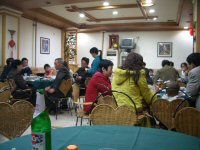
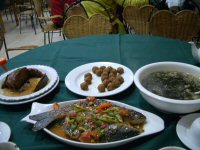
19:09: Our first restaurant in Guilin, a local family-style place.
19:28: And our first contact with beer fish: I liked it, but couldn’t taste any beer except for the one I ordered as usual. But they had no cold beer…noone ever asked for it before me 😉
The meat dish in the top-left corner is also a regional speciality, which Carol had noted down, but I forgot the name. It were slices of beef mixed with slices of some kind of potato-like fairly dry mass. I liked the meet, but that other intermixed mass was not so great. Good where the small brown balls in the middle.
After the meal we took a normal public bus to “Guilin Bus Station”, which turned out to be just a normal bus stop at the side of the street. Maybe the long distance busses you usually expect to be there were somewhere in the back…I didn’t see them. But there was a tourist information right next to it with a very friendly young lady telling us the way to our hotel and selling us a pretty good map of Guilin, which included local bus lines. The Osmanthus Hotel, which we stayed in, was as other Chinese tourist hotels: From the outside you don’t dare to walk in, inside everything clean with exaggerated decorations, but when looking at details already a bit worn-out. Although not booked we got a “Riverside View” room, which had quite nice a view out on one of the four rivers of Guilin.
Guilin at Night
We went out immediately again for a stroll through Guilin at night. Once you left the busy shopping streets with their annoying over-bright and blinking advertisements Guilin actually looks great. They have made a lot of efforts to make a stroll along their many rivers an enjoyable evening activity.

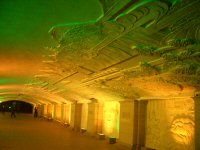
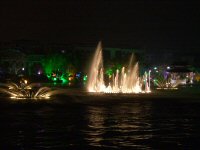
21:50: Twin Pagodas, one symbolizing the sun, one the moon. They actually contain a tea house but charge 40RMB just to cross a bridge to the first pagoda…you’ll get an idea what Lonely Planet means when writing “locals don’t shy away from cashing in on Guìlín’s popularity.”
22:16: Footpath beneath a bridge of Zhongshan Zhonglu, crossing yet another river, connecting two inner-city lakes.
22:22: Water fountains in that other lake, playing to music (a bit out of rythm ;))
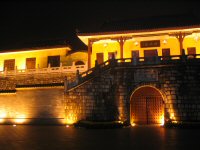

22:34: Ancient South Gate (Gŭ Nán Mén, and although the stone facade looks ‘restaurated’, like Chinese officials like to put it, which actually means: torn down and rebuilt, they did give it an ancient touch even with the character inscription, which simply cannot be original: Nobody would write ‘ancient’ at a gate, which he had just built…naja, what I mean is: The characters are written the old way: right-to-left and in their traditional form: 門南古)
22:52: One of the many promenades along Guilin’s rivers. The illumination is quite characteristic…and over time exaggerated; it doesn’t exactly look natural any longer.
Tuesday, 20-FEB-2007: Breakfast
We gave it a try: The hotel officially offered something they call “Western Breakfast”. We would have been the only guests in a deserted second-floor-around-the-lobby-attempt-of-a-cafe, where 2 employees were only busy polishing silverware. One of them handed us a menu, apparently without much hope that we would stay as she did not even ask us to sit down first. We looked at the options and were glad that we haven’t taken the effort to sit down. Breakfast was something about egg with dry toast in 3 different variations. We asked for the way to the Chinese breakfast restaurant and found a buzzling big (though by no means more stylish) restaurant on the first floor, full of families and tourist groups, loud, lively, the complete contrary.
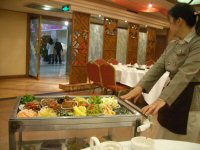
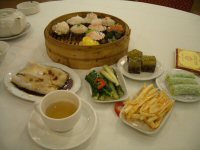
09:33: Buffet a bit differently: The food comes to the people instead of the people to the food:
09:21: You pick a lot of dishes and only in the end figure out that this dumpling selection makes this breakfast more expensive than yesterday’s dinner…
Elephant Trunk Hill
The next 20RMB, or were it 40? That hill is one of the highlights of Guilin, so tourist books and locals say. Why, the hell? It’s boring…forget it, save that money.
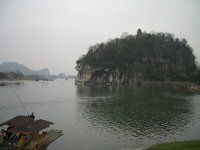
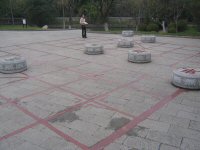
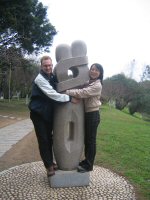
11:03: Elephant Trunk Hill: Now tell me, what’s so great about it? I needed 10 minutes explanation to figure out that the elephant’s trunk is supposingly this overhanging rock to the left and the hole in the rocks (which on this picture is difficult to make out) is the room between trunk and mouth. Great.
11:10: You know Chinese Chess? An installation on one of the small connected islands making up Elephant Trunk Hill Park. It makes sense in so far as the Chinese Chess (象棋=Xiàng Qí) translates to “Elephant Game”. Consequently one of the pieces is called Elephant and is in traditional games marked with the Chinese character 象 (Elephant) on the black pieces. Its counterpart on the white side is 相 (Prime Minister, both pronounced Xiàng). In my photo you see an Elephant on the left and a Prime Minster in the middle


11:14: Carol and Birger embrace a statue of embracing people.
Reed Flute Cave
Again no typo, it’s not red, but reed, in Chinese 芦笛岩=LúDí Yán, a Reed Flute being an instrument in which the vibrating reed (german: Schilf) makes the sound. Don’t know what that has to do with the actual cave…but sounds nice, doesn’t it? 😉
Getting there is the first story: As we were warned about the cashing-in locals we wanted to get to that cave by bus. There was even supposed to be a free (yes, really, free, meaning: nothing to pay!) bus, line 58, out to that cave. Maybe it’s really free…we found only 52, for which the bus stop sign really said “Free for the benefit of the public”. (You cannot just state something in China, you have to give reason. You cannot just say “the traffic light shows red”, you have to say something like “the traffic light shows red to make the cars stop, which is to the benefit of all traffic participants, cars and pedestrians alike, and to the benefit of the Chinese people, the hospitals, and the police”, making sure that all of the reasons sound somewhat obvious, but cannot be deducted down to the detail.)
Where was I? Ah, right. The 58. We didn’t find it. Despite asking a lot of locals. But they literally all pointed into different directions. And where the city map said that a 58 bus stop should be there was a bus stop, but no 58. We finally gave up on 58 and tried to find number 3. That is not a free bus, but 2RMB sounded still bearable. We didn’t find 3 either.
We found a taxi. And when the taxameter already showed 12 RMB, half-way out to the cave, the driver offered us to take us around all day for just 30RMB. Carol even negotiated it quickly down to 20RMB without much additional effort and we accepted. When we arrived at the cave the taxameter, which still was not stopped, showed 16RMB. I was wondering, why the hell the driver offered to take us around all day for just 4RMB more than he would get anyway? I couldn’t really find it out. But at the cave there were many taxis waiting, likely for the same reasons as ours: They were waiting for their guests. Most tourists arrive on organized tours in tourist busses which the taxis make no business with.
The cave by itself was really great! For example, it had the great admission fee of no less than 60RMB (yes, sixty, liushi, sechzig, and yes, per person). But it was worth it as it also had some really great underground scenery, as usual fancily illuminated, and the ways between every 2 sight spots very short. Despite the price it’s worth it!
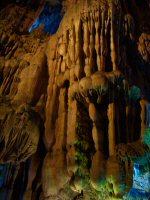
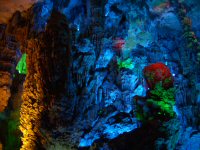

12:56: Looks to me like an pipe organ, but I believe it was pronounced to be lotus roots. There were many funny inventive names for different sights in the cave. You can’t always figure out why…
12:58: Flower blooming in thousand years or something like that. With the red color you can identify it easily. Without it’s probably hard…
12:59: Careful, sliding people ;)) Oh, I loved this sign…if they would offer it on a T-Shirt I would buy it immediately! Could get cult status like the East-German Traffic Light Man. In fact, the cave was generally surpringsly dry but at times the warning made sense.
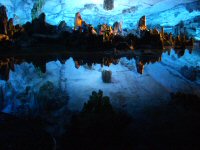
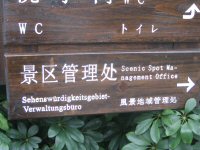
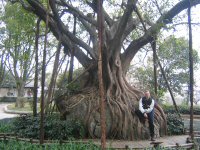
13:10: Underground lake with mirrored rocks in the back, arguably one of the nicest spots of the cave.
13:47: Sehenswürdigkeitsgebiet-Verwaltungsbüro! Damn…why does Germany not have anything like that? And who does these translations? I mean…it is actually fairly good, though so long a word no German would voluntarily use. And why did all the signs (not only this one) have German translations? Other translations I found included “Umgearmter Stein”, also nice…please see this “Embracing Stone” in the next picture; or “Besteigungsweg” to the hill’s near-top.
13:50: Embracing Stone: A tree, which somehow found it comfortable to grow on top of a rock.
Our taxi had indeed waited for us. The still running taxameter now showed 47RMB! Carol said something sounding a bit harsh, pointing to the innocent device, and the driver hurried to switch it off, saying something like “Sorry, forgot to switch off”. It actually sounded convincing. He brought us to our next destination, the Solitary Beauty Park, not without stopping by a “free Museum” on the way, which certainly turned out to be a jade selling shop. Well, I have to admit that some of the exhibited ‘museum’ pieces in the beginning really looked nice. But the shop room in the end was a lot larger than the ‘museum’ room in the beginning. We found our way out after trying some arm rings without buying them when a huge tourist group entered.
Solitary Beauty Park
独秀峰=Dúxiù Fēng. Lonely Planet says 15RMB, the sign at the cashier said 50. Well…English pronunciation at least is similar…but all the money gone nonetheless.
The only solitary thing in that park was that karst hill at its northern end. Otherwise it was packed with people. And we were allowed to enter only by being joined with a tourist group with guide. All guides certainly spoke perfectly…Mandarin. Well, Mandarin was still better than any kind of ununderstandable local dialect as at least Carol could follow and every once in a while threw some pieces of information at me. But as the guide nearly never stopped talking Carol had a hard time finding some time for passing on news. So this guided tour was fairly boring for me as I also couldn’t really identify the greatness of the few buildings.
The layout of the park resembles a bit the Forbidden City, certainly a couple of magnitudes smaller. And indeed it used to be kind of a palace for a local governour, a nephew of a Ming emperor.
Most time we actually spent within that karst hill at the northern end, where there were lots of lucky figures painted to the rock walls along an underground path within the base of the hill, 60 figures in total, one for each year, repeating after 60 years. I knew this concept from Taoist temples and found it not more interesting. But all the Chinese seem to have been amazed. And it was even more amazing that the group (remember…we had to stick to that tourist group) spent more than half an hour in a small shop at the end of this underground way, which sold pictures and paintings of all these lucky figures…bringing the luck in your home…and we waited, and waited right outside that shop, were surprised to see our taxi driver waiting for us there, too, apparently knowing where we would come out…and finally went to the hill’s top (very steep) on our own, enjoyed the view (wasn’t that great as it was all cloudy and hazy) and went down again. The tourist group was still not finished buying. Carol talked to a few officials and we finally went to the next sightseeing spot (the examination place, were in ancient times prospective officials made their exams) on our own, were so lucky to just step in when a kind of mini-show started for another tourist group, intermingled with that group and had a bit of fun following their show.
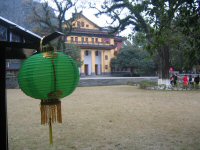
15:03: The only picture I could reasonably select for that park. You see: A green lantern (ah, why green? why not red? lanterns in China have to be red, don’t they? Maybe it is THE tourist attraction in all Guilin: A green latern…well…I don’t know), some tree which reaches its arms to the sky (at the top right corner, a bit hidden behind the branch with leafs), a building which we did not enter, and to the left and right of that building’s entrance two well-trimmed trees, one a bit hidden behind the latern, which were planted by Sun Yatsen (the founder of the Republic of China) and his wife. And if I remember the story correctly then both trees bloom every year, but only the wife’s tree carries fruits.
Actually quite comprehensive a picture, isn’t it? Especially given the fact that I made it before learning about the sky-reaching and Sun Yatsen trees… 😉
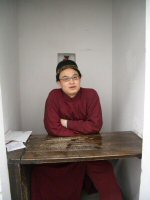
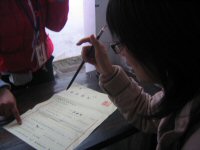
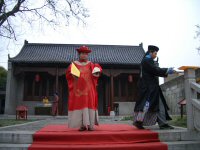
16:27: Wow…that is really nearly one and a half hours after the green lantern…:
The examination show master. That guy had a surprising fun during his 5 minute show, although I would assume they do that every day dozends of times.
16:32: The tourists could also do an examination in the same booths used in earlier times…Carol was great painting some characters in there…but left also some empty space…well, we didn’t win 😉
16:35: But this shy girl did, who was apparently a bit too small for the clothes.
Seven Star Park
Our taxi, which had taken the opportunity of our long stay in the park to do some additional business, brought us across the Li River to the Seven Star Park (七星公园=Qīxīng Gōngyuán). When we entered our taxi driver tour guide shouted something after us that we would be picked up for a guided tour somewhere…we made sure, however, that we made our way ourselves. We had enough Chinese tour guides for one day.
According to Lonely Planet it has seven hill peaks resembling the Big Dipper star constellations (in German called “Kleiner Wagen” oder “Kleiner Bär”). That would sound remarkable. But within the park I got the impressions that the number 7 referred more to the actual attractions, something like two caves plus a few hills plus a few other things, summing up to seven. Well…it would have probably been a nice park if it would have been more sunny. But we saw already a fantastic cave, so we skipped the small ones within the park, walked straight through it, spent some minutes in the mini zoo (with a number of animals kept in extremely poor conditions like a tiger in a round cobblestoned cage of probably 3 meters diameter), and ended up on the other side at Camel Hill, one of the many karst hills, now in the shape of a…well…don’t wanna take away the surprise… 😉

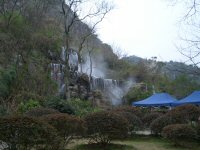
17:07: Some square dedicated to great recent history of China…we didn’t get into the details.
17:13: Some waterfall on the way. Looked nice, but I had to disappoint Carol by pointing out that the nice-looking smoke is artifical: If you look closely you can see the nozzles, which jet the smoke. Like it or not…Chinese are great in creating artificial landscape. But it always makes me feel like “everything’s fake” and I keep looking for proofs of it being faked. That spoils a bit enjoying it.
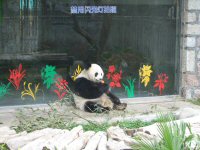
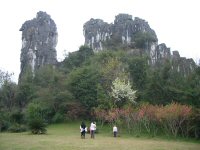
17:30: A panda in the small zoo. The panda had a fairly big enclosure, even with some grass and small trees. But it prefered the beton balcony of its vast and empty house for chewing its carrot. I wanted to see what the panda would do after it finished the carrot. But what it did was: Nothing.
17:47: And here it is: Camel Hill looks like….a Camel!
OK. End of park. End of sightseeing. The last good deed our taxi driver did to us was to bring us to a restaurant. We gave him 30 RMB as he originally asked for instead of the negotiated 20 RMB, ate some meat at the restaurant, which was supposingly dog meat (I could not taste the difference to pork) and then had another walk through Guilin at night.
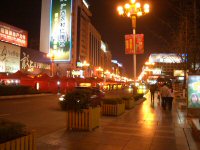
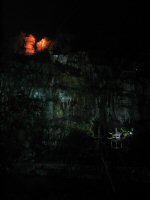
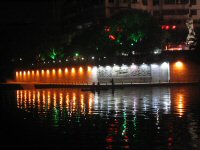
20:13: Zhongshan Zhonglu, lined with tents while we were there, selling all kinds of souvenir stuff, repeating itself after the third or fourth tent.
20:30: Elephant Trunk Hill again, a side view with little pavillion and some tower on top.
20:47: If you look closely (you may want to click on the thumbnail for the full-sized picture) you find a bamboo raft in front of the white illuminated wall, commuting between 2 shores of yet another river of Guilin, used by locals as kind of a ferry. We’ll find lots of these bamboo rafts tomorrow when shipping down the Li River.
End of Guilin, which was expensive and looked nicer to us at night or in the caves than at daylight. Might be due to the cloudy (but luckily dry) weather, but honestly…more than a day is wasted time in this city. We were looking forward to our river cruise!
Categories: Reise, Shanghai
Originally Created: 02/26/2007 07:16:38 AM
Last Edited: 02/26/2007
One thought on “Guilin 桂林”
Comments are closed.